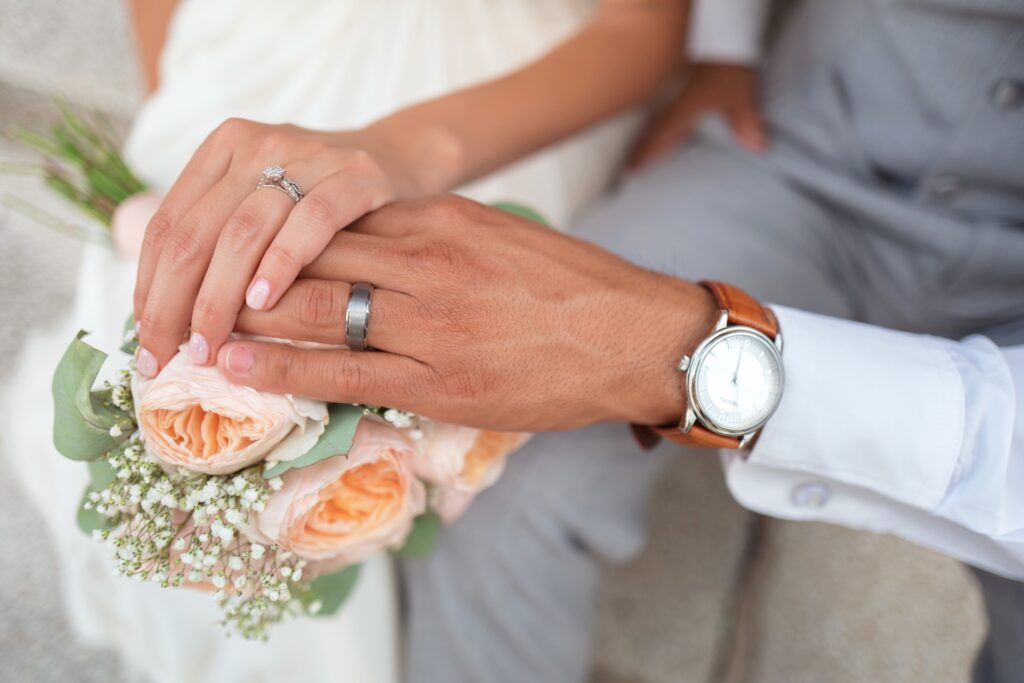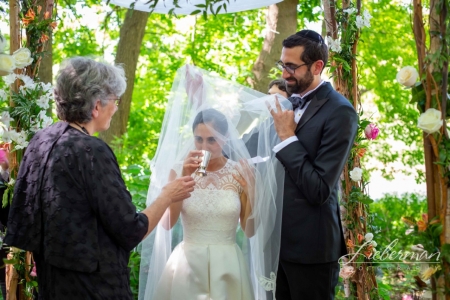Love. Acquisition. Mutual obligations. Inequality. Covenant. Partnership. Each of these words, though conflicting, reflect Jewish approaches to marriage. Therein lies the beginning of the dilemmas we faced over the year as each of us went through the process of getting married.
We are both feminists and Jewish communal professionals. Heather is a Conservative rabbi, Susan works at Ma’yan. We are both women who had dreamed of finding a partner to marry and who believed strongly in the power of ritual. Yet as each of us learned more about the rabbinic treatment of marriage (in Hebrew, kiddushin) we found it increasingly difficult to separate the wedding ritual from its patriarchal history. In Judaism marriage is based on a legal form of acquisition. It is a one-sided deal; the groom “acquires” rights to the bride. He speaks and acts; she is silent and passive.
Kiddushin comes from the Hebrew root k-d-sh, which is often translated as consecrated, made holy, or set apart. “Harei at mekudeshet li,” the phrase uttered in the wedding ceremony, is often translated as “Behold you are consecrated to me,” implying being set apart for holy use. The problem with this is that only the woman can legally be set apart for the man. A man, according to Jewish law, cannot be consecrated or set apart for a woman. (And technically, he can also set more than one woman apart for his holy use, a practice forbidden to women.)
Kinyan (Hebrew for “acquisition”) is what establishes a Jewish marriage. Kinyan is effected when a man says to a woman the “Behold…” phrase, and gives her something worth more than a penny, which she accepts with the intention of being married. She has then, in a sense, been acquired by the man. It is important to note that in order for the marriage to be valid, the man must initiate the action and there can not be a perception of mutual exchange in the transaction. According to tradition, the role of the woman is only to be acquired; she is a recipient and not an active participant. Thus, despite the panorama surrounding the marriage ritual, marriage is a form of acquisition. Kinyan is used in the Talmud and later texts to signify commercial transactions. Although acquiring a woman differs somewhat from buying a field (a common Talmudic analogy for marriage) it is clear that in classical Jewish texts, women are classified as objects and ownable property. In biblical and modern Hebrew, a husband is a ba’al, which literally means master or owner of property. A wife is simply an isha, a woman. By implication, all Jewish women are wives-in-waiting.
Given all of this profoundly distressing information, we Jewish feminists who try to find meaning and inspiration in Jewish texts and rituals could not ignore the clear fact that women are circumscribed in the halakhic view of marriage. Given that inequity is not part of either of our views of marriage, could we reconcile our desire to have wedding ceremonies that would represent our ideals of marriage with the traditional form of a Jewish marriage?
The marriage ceremony wasn’t the only problem. The inequality reflected in the marriage documents also disturbed us. The ketubah, generally thought of as a wedding contract, is not a contract between partners. Underneath the flowers and pastel images of Jerusalem is a statement from the groom that details his financial obligations toward the bride (calculated according to her sexual status—virgin or non-virgin). Many rabbis and modern Jews value the ketubah for its authenticity and even claim that it was meant to protect women. In Rereading the Rabbis, Judith Hauptman makes the case that the rabbis of the Talmud made far-reaching legislative change to the biblical marriage laws. The laws were amended when society changed, and women became regarded as individuals with a right to consent to (or withhold consent from) a marriage.
But women’s status today is much different from Talmudic times. Thus marriage laws and ritual must also change. If we are today finally equal, we should have a legal document that reflects this hard-won reality. Isn’t there a way to maintain authenticity while revising the marriage contract to involve the intentions and obligations of both partners?
As we pondered these questions, Engendering Judaism, a recent book by Jewish feminist theologian Rachel Adler, caught our attention. In it, Adler proposes a radical new construct for marriage based on partnership rather than acquisition. We read her book eagerly and discussed it endlessly. We were both in serious relationships, struggling not only with the idea of committing to a partner for life, but also wondering if we did make the commitment how we could create a marriage ritual that reflected our beliefs in the equality of men and women in Judaism. Our relationships were based on respect, mutuality and partnership; our weddings should also reflect these principles.
Adler’s ceremony, the B’rit Ahuvim (lovers’ covenant), is based on an ancient Jewish legal business partnership in which each partner contributes to a joint entity by pooling their resources in a pouch and lifting it together.1 The partnership model also solves another problem that stems from kiddushin—the agunah (chained woman). Since a marriage based on kiddushin is created with the sole action of the groom, the termination of the marriage is also solely in his hands. If a husband refuses to give his wife a get (Jewish divorce document), the marriage continues until he relents. With Adler’s model which eliminates kiddushin, the marriage is a joint partnership from the beginning. The Brit Ahuvim is also appropriate for same-sex Jewish marriages, unlike kiddushin, which is solely heterosexual.
We both loved Adler’s idea, but our commitment to halakhah prevented us from stepping outside the boundaries of tradition so radically. We realized that it would be a very long time before the Brit Ahuvim would be recognized as a legal marriage. Most Jews, even self-identified feminist rabbis whom we consulted, seemed willing to live with the contradictions between their aspirations for a marriage of equality and a ritual based in inequality.
Intellectually energized but confused, we discussed the various options, and then went to our fiances to figure out how, if at all, we could incorporate the Brit Ahuvim into our respective weddings. Both of us decided to go ahead with the partnership ceremony in addition to the traditional kiddushin. The partnership would come first, so in our eyes, it would be the marriage ceremony. The kiddushin that would follow would be our homage to tradition. The Brit Ahuvim includes many elements that mirror the traditional kiddushin ceremony, such as rings, blessings over a cup of wine, and a document that lists the couple’s obligations to each other. It was with this document, or shtar, that each couple expressed its creativity and commitment.
In creating their Shtar Brit (Covenant Agreement), Heather and her husband-to-be Eric followed Adler’s suggestion that the partnership be based on covenant. They used elements of Adler’s model of a Shtar Brit in Engendering Judaism and cited biblical images of covenant and the principles embedded in them. Susan and her husband-to-be Lewis wanted their Shtar Shutafut (Partnership Agreement) to be more specific in listing mutual commitment and obligations. So they sat down one night, surrounded by many different sources including copies of egalitarian ketubot from friends, Engendering Judaism, and ceremonies and documents from Lifecycles, vol.1, and started to think about what they wanted in a partnership agreement. They created a document that was similar to traditional tena’im, conditions stipulated by both bride and groom before the wedding. Unlike the traditional ketubah, tena’im have been mutual. Susan and Lewis’s tena’im focused on their obligations to each other in different facets of their marriage—economic, domestic, and personal—with different biblical and rabbinic quotations as prooftexts. The focus of the ketubah is on what happens if the marriage ends: they wanted a document according to which their marriage could live.
In the actual wedding ceremonies, each couple began with their variations of the Brit Ahuvim. Heather and Eric signed the shtar (along with two other witnesses), as they were the parties to the agreement. (Traditionally the bride and groom do not need to sign the ketubah, it only needs to be witnessed by two others.) They then read aloud to each other from the shtar. Once they declared their intention to be true partners, they each put some of their belongings into a pouch. They chose car keys and new house keys to symbolize the financial side of the partnership, private letters to each other that reflected the emotional and spiritual promise of the partnership, and their wedding bands. Once Heather and Eric raised the pouch together, everything inside became part of the partnership.2 They recited the blessing that Adler suggests, which recalls the brit and is said upon seeing a rainbow: “Blessed are You, who remembers Your covenant and is faithful to Your covenant and keeps Your word.”
At Susan and Lewis’s wedding, the English and Hebrew versions of their shtar shutafut were formally witnessed by two pairs of friends at Susan’s tisch (reception) while Lewis held court in a separate reception. After Lewis was led by a throng of singing and dancing guests over to Susan, Heather facilitated the shutafut ceremony. Susan and Lewis signed the shtar and Heather then read a short section of the document aloud. Susan and Lewis placed personally significant items (including a miniature replica of Engendering Judaism) and coins in a bag that was specially decorated by Susan’s rosh hodesh group for the occasion. They lifted the pouch together and declared in Hebrew: “May our marriage, which will soon take place under the wedding canopy, be a covenant of partnership and trust, and thus may we establish a household among the people Israel.” After kiddushin under the huppah (wedding canopy), where Lewis gave Susan a ring and the traditional ketubah was read, Susan gave Lewis a ring. Heather, one of the four rabbis who participated in the ceremony, read the shtar shutafut aloud.
The brit shutafut ritual was, in our eyes, a complete marriage ceremony. In the eyes of halakhah, however, the kiddushin under the huppah was the main event. In the end, while we both incorporated and made central the partnership aspect of our wedding ceremonies, through our adaptations of the Brit Ahuvim, we still both decided to be acquired through kiddushin/kinyan as part of the wedding. We allowed ourselves to be “co-opted by the system” for a complex set of personal, historical, and halakhic reasons. Sometimes the weight of tradition, as distasteful as it can be, is too difficult to abandon. We hope that more couples will be conscientious objectors to kiddushin and will formalize/solemnize their relationships with the Brit Ahuvim. Community customs and “facts on the ground” can often lead to radical changes in Jewish law. We hope that this detailed sharing of our process will make it easier for you to join us in re-negotiating the covenant.
Selection from the Shtar Shutafut/Partnership Agreement of Susan Sapiro and Lewis Polishook
On the first day of the week… the bride, Susan Ellen, said to the groom, Lewis Aaron, “Be my companion and husband in covenant according to the customs of the people of Israel.” The groom, Lewis Aaron, replied, “Do not call me master, call me husband,” and accepted a ring from the bride, Susan Ellen. The bride and groom then declared that they are entering into this marriage as a full and equal partnership, according to the terms of the agreement set forth below…. They will live a life of full and equal partnership in all that requires decision, in domestic duties, and in family roles. They will make their home their first priority, and the source from which their lives will flow, as it is said, “A house is built by wisdom, and is established by understanding; by knowledge are its rooms filled with all precious and beautiful things” (Proverbs 24:3-4)…. They will strive to nurture each other’s personal and professional growth and joy of living…. They will honor each other’s opinions and concerns when they disagree, as it is said, “The more counsel, the more understanding” (Sayings of the Fathers 2:8). They will not conceal from each other any of their material possessions, and will work together as equal partners to secure sustenance for themselves and their families, as it is said, “Two are better off than one in that they have a greater benefit from their earnings” (Eccles. 4:9). The bride and groom will always seek to actualize in their daily lives the vision set forth in this partnership agreement. May the One to whom past and future are as one bestow a good name and longevity to the terms of this partnership and its undertakings.
Selections from Shtar Brit Shutafut/Document of Covenantal Partnership of Heather Altman and Eric Flam
On the first day of the week, … Heather and Eric entered into a holy covenant like the ancient covenants of our people, mutually made in faithfulness and trust to bind them together for all time.
This partnership is a covenant of protection and hope like the covenant God swore to Noah and his descendants. Heather and Eric agree to protect each other and strive to nurture each other and their partnership….
It is a covenant of mutual lovingkindness like the wedding covenant between God and Zion, as it is said, “I will espouse you forever. I will espouse you with righteousness and justice and lovingkindness and compassion. I will espouse you in faithfulness and you shall know God.” (Hos 2:21-22)….
In the presence of witnesses, the following declaration Eric said to Heather, and then Heather declared the same to Eric: “With all my heart, soul and might, I enter into this sacred covenant to be your partner in life, love, and learning. I set myself apart for you to be yours exclusively. I will respect you, honor you, and support you…
Heather and Eric willingly and joyfully agreed to the conditions of this sacred and intimate covenantal partnership. Each contributed from their property to symbolically join their being and possessions. The rings which they contributed will serve as a reminder of their partnership covenant, as the rainbow did for God’s everlasting covenant with Noah and his descendants.
————————-
Originally published in Ma’yan’s JOURNEY. Used by permission of the authors. Heather Altman is the Assistant Rabbi of Anshe Emet Synagogue, Chicago, IL. Susan Sapiro worked at Ma’yan for 4 1/2 years.












